 I love lanterns, their warm light, and the ambiance they create in every season, both inside and outside the house. And so, for this tutorial, I decided to create a 3-D cookie version with a bare chocolate cookie frame and big, broad expanses of isomalt "glass" to let the light really shine through. The lantern doesn't have a bottom, so it's easy to just set it over a tea light. I also cut some notches at the base to create "feet", and to give me plenty of room to slip my fingers underneath to move the lantern around. This project could be a showpiece on its own, or the focal point of a larger centerpiece surrounded by themed cookies of your choice.
I love lanterns, their warm light, and the ambiance they create in every season, both inside and outside the house. And so, for this tutorial, I decided to create a 3-D cookie version with a bare chocolate cookie frame and big, broad expanses of isomalt "glass" to let the light really shine through. The lantern doesn't have a bottom, so it's easy to just set it over a tea light. I also cut some notches at the base to create "feet", and to give me plenty of room to slip my fingers underneath to move the lantern around. This project could be a showpiece on its own, or the focal point of a larger centerpiece surrounded by themed cookies of your choice.
- Chocolate cookie dough
- 1 large (10 x 15 cm/4 x 6 in) rectangular cookie cutter or cutting template, for four lantern sides
- 1 large (10 x 10 cm/4 x 4 in) square cookie cutter or cutting template, for lantern top
- 1 small (6 x 6 cm/2 3/8 x 2 3/8 in) square cookie cutter to cut windows on top and sides of lantern
- Plaque cutter of your choice (I used one from this set.)
- Zester or Microplane tool, for mitering cookie edges
- Paint brush
- About 3/4 cup isomalt (or 5 to 7 teaspoons per lantern side/top)
- Candy thermometer, ideally a quick-read digital one
- Yellow and red gel or liqua-gel food colorings
- Silicone mat, on which to pour isomalt
- Very thick brown royal icing (Julia M. Usher calls it "glue"; see her video for reference.)
- Scribe tool
- LED tea light and decorated cookies of your choice (latter, optional)
Step 1: Roll, cut, and bake cookies
As I mentioned above, this lantern has no base, so we just need five (5) cookies in the following shapes: 4 rectangles for the sides and 1 square for the top.
a. Roll the dough about 0.6 cm/1/4 in thick. Cut 4 (10 x 15 cm/4 x 6 in) rectangles and 1 square (10 x 10 cm/4 x 4 in). If you don't have cutters in these sizes, you can make your own templates, lay them on the rolled dough, and cut along their edges with a sharp knife. To minimize spreading, I always chill the dough before cutting and chill the cut cookies before baking them. I also do the entire rolling and cutting process on parchment paper, so I can transfer the cookies directly on the paper to the baking sheet without misshaping them. But, before baking these cookies, we have some more cutting to do in Steps b and c, below.
b. With the small (6 x 6 cm/2 3/8 x 2 3/8 in) square cookie cutter, cut a window in the center of the square cookie.
c. Then, with the same square cutter, cut a rectangular window, about 6 x 10 cm (2 3/8 x 4 in), in each rectangular cookie. To do this, first cut a square at a distance of 2 cm (3/4 in) from the top and sides, and then another one, directly under the first, at a distance of about 3 cm (1 1/4 in) from the bottom. Last, with the plaque cutter, cut a notch in the center bottom of each rectangle, cutting in no more than 1 cm (1/2 in) from the bottom edge. Tip: To get a neat cut on all of the cookies and windows, clean the edges of the cookie cutter after each cut.
d. Bake the cookies as directed in your recipe, and let the cookies cool completely.
Step 2: File cookie edges
Because I wanted a very clean design for this lantern, I filed the vertical and top edges of each rectangle (lantern side), and all the edges of the square (lantern top). By "file", I mean I mitered each edge at roughly a 45-degree angle. Mitered edges allow the lantern pieces to fit more closely together at the corners, eliminating the need to cover the seams with royal icing or fondant. It’s a carpenter job, and these are cookies, but why not if the outcome will be neater and cleaner?;
To miter the edges, turn over the cookies and lay them face down on a table. Push them very close to the table edge; hold the zester (or Microplane tool) at a 45-degree angle to the table top; and file the full length of each cookie edge, as shown in the photo above. Once you have filed all of the cookie edges, brush them with a paint brush to remove any crumbs, as they will otherwise end up in the isomalt "glass" in the next step. And that would not be a good thing!
Step 3: Cook isomalt and fill cookie windows
In this step, I worked on one cookie window at a time, melting and coloring a small amount of isomalt each time (5 teaspoons for the top, and 7 teaspoons for each side). Since isomalt will cool and set very fast once it's reached the required temperature, it's typically easiest to work with the smallest quantity possible and to use most (or all) of it in one pour. I also wanted a very thin layer of isomalt in each window, so it would sit below the top of each cookie.
a. Put about 5 to 7 teaspoons of isomalt into a small saucepan, ideally with a pouring spout, and place the pan over low heat to gradually melt the isomalt granules. (If you're nervous about melting dry isomalt granules, you can add a little water to create a slurry, and then prepare the isomalt exactly as described above, and in Steps b to c, below.)
b. As the isomalt begins to melt, gently agitate the pan to encourage even melting. To prevent recrystallization of the syrup, use a damp brush to "wash" any granules off the pan sides and into the syrup. Once all of the granules have melted, increase the heat to medium to medium-high, and bring the isomalt syrup to a boil. Closely monitor the temperature of the syrup with a candy thermometer (and ideally a quick-read digital one, as it will register temperature changes more quickly and clearly than a regular candy thermometer). Continue to boil the syrup until it reaches 138°C (280°F). It's normal to see a lot of bubbles at this stage.
c. With the syrup still on the burner, gradually add gel or liqua-gel coloring of your choice. (I used red and yellow for some windows, and a mixture of red and yellow to create orange for others.) Stir the coloring until it is evenly distributed. Be careful, as the mixture will be extremely hot. Continue to boil until the syrup reaches 160°C (320°F). It's very important to bring the syrup to this point, or it may not set up firmly, and/or could cloud and become dull over time. NOTE: It's possible that the instructions on your isomalt package may deviate from what I've said here. For instance, some instructions suggest taking the syrup to 170°C (338°F) to 180°C (356°F). It's best to defer to your package instructions. However, please be careful at temperatures much beyond 160°C, as the syrup can begin to caramelize (turn brown) at about 163°C (325°F), and it can quickly burn, especially when working with the small quantities suggested here.
d. Your isomalt is now ready. Remove it from the burner, and let it cool for a couple of minutes before pouring it. You will see the bubbles disappear little by little as the syrup cools.
e. While the syrup is cooling in Step d, lay your cookies on a silicone mat. Once the bubbles have subsided to your satisfaction, pour the isomalt into one of the cookie windows. Don't wait too long, or the syrup will cool too much and become too thick to pour evenly. Make sure the isomalt gets into all of the corners!
f. Repeat Steps a to e for the remaining windows, changing up isomalt colors as you go. Let the isomalt cool completely on the mat. It should be very hard (like candy) before you attempt to remove any cookies from the mat. If you do not plan to assemble and display the lantern immediately, it's best to store the cookies in an airtight container in a cool, low-humidity environment. Even though isomalt is less humidity-sensitive than regular sugar, it can still cloud or wilt under humid conditions.
Step 4: Assemble cookies
I recommend doing all of the assembly on a silicone mat, so that if you accidentally drop a cookie, there will be less chance of breaking it.
The sides:
a. Pipe very thick brown royal icing (aka "Julia's glue") along the vertical edge of one of the rectangular cookies that was filed in Step 2, and attach it to another side, making sure the sides are perpendicular to one another and stand straight up. If the consistency of the icing is right, the paired sides will stand without any props. However, as an extra precaution, I propped them from the outside with some glasses. I also placed the large square cookie cutter inside the two cookies just to make sure they were completely perpendicular before I set them aside to dry. Repeat this step with the other two sides.
b. If needed, remove any excess icing along the outside corners with a scribe tool. I needed to do this for just one corner, as I had used too much icing on it.
c. Reinforce the corners by piping more "glue" along the inside seam. Push the icing into the seam with a paint brush, or with your (clean) finger, and let the two parts dry for at least 10 minutes.
d. Glue the two half-lanterns together to form a box, and repeat Steps b and c, above, for the newly created seams. Let the icing set just a few minutes; then proceed to the next step.
The top:
e. Pipe brown “glue” along the top edges of the lantern.
f. Now place the square cookie on top, as if it was the lid of a box. The lantern should now be completely closed off at the top.
g. Apply a little pressure to make sure the top is secured to the rest of the lantern.
h. If needed, use a scribe tool to remove any excess icing along the top edges. Let the icing set for at least 30 minutes.
The lantern is ready, and we can start enjoying it even as it is drying. I placed mine over a LED tea light, and surrounded it with cookie leaves in different colors to make a fall-themed centerpiece. (Again, it's best to move the lantern by inserting your fingers into the notches at the base and carefully sliding or lifting the lantern into place. Also, don't use an open flame under the lantern, as it can melt the isomalt.)
The sky's the limit as far as different isomalt colors and themed cookies are concerned. I leave your design to your imagination!
Credits and variations:
Julia M. Usher's "3-D Retro Oven Cookie" video surely planted the seeds for my vision of this lantern. When I first saw Julia's video, I was drawn to the isomalt oven window and the texture that the silicone mat left on its surface. So, once my first lantern was finished, I made another one to experiment with different textures on the isomalt by using various silicone mats that I have at home. I made this short video of my results. Enjoy!
Ciao, Manu


Photo and cookie credits: Manuela Pezzopane
Note: Made by Manu is a Cookie Connection blog feature written by Manuela Pezzopane, where each month she shares the method behind a magical cookie of her own making. This article expresses the views of the author, and not necessarily those of this site, its owners, its administrators, or its employees. To read all of Manuela's past Made by Manu tutorials, click here. And to see all of Cookie Connection's tutorials, click here.

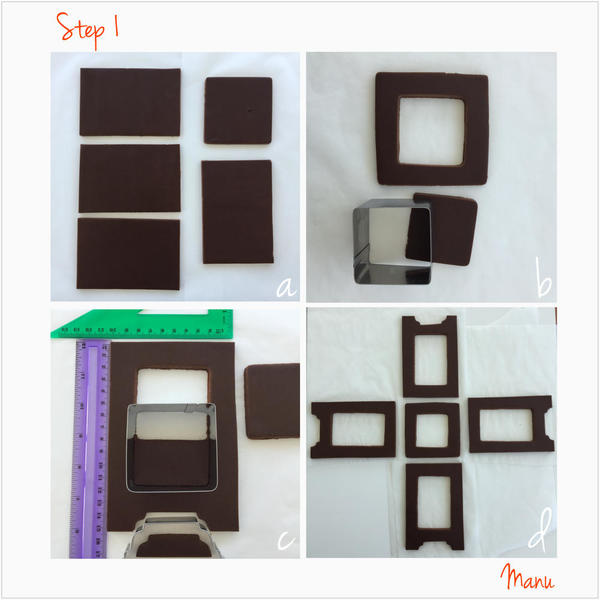


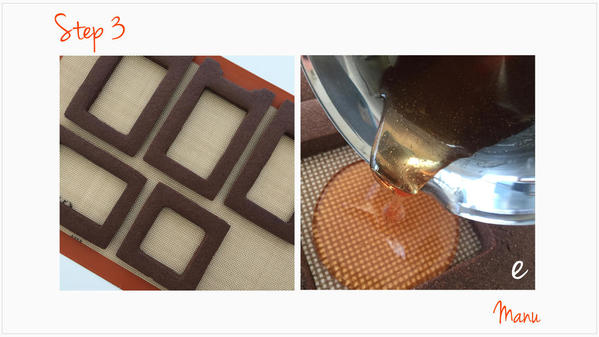

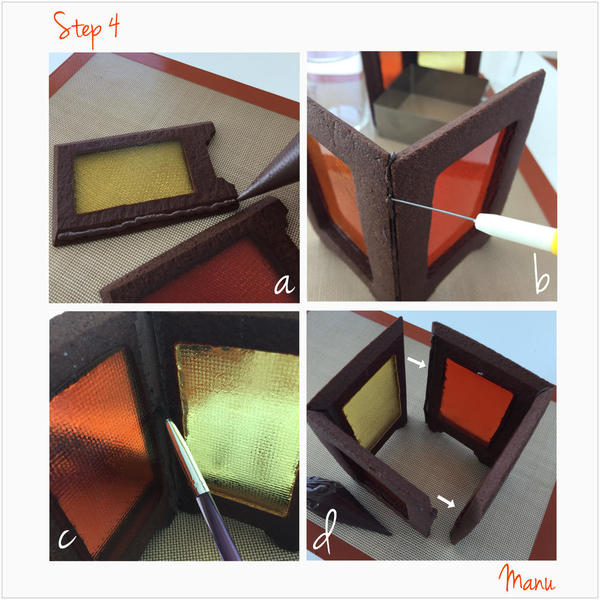
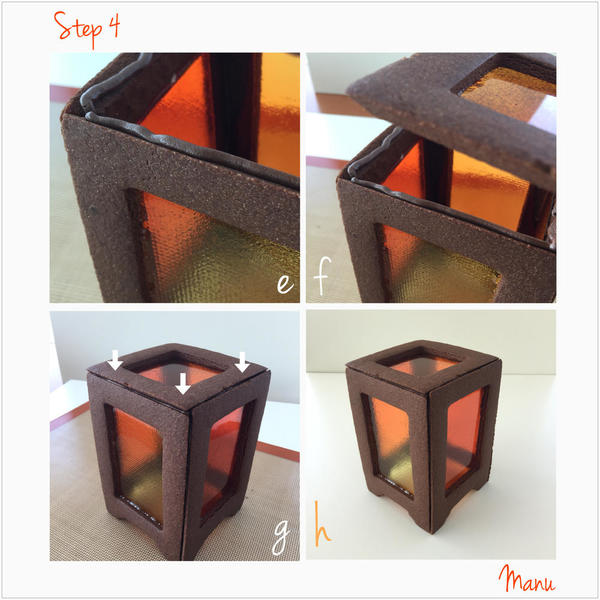
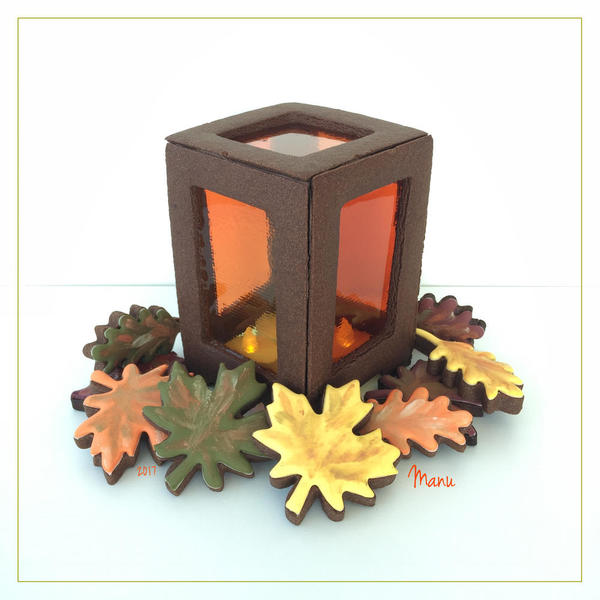








Comments (35)